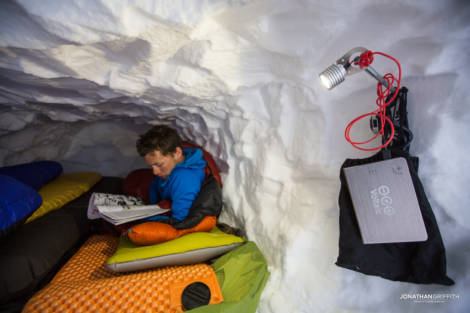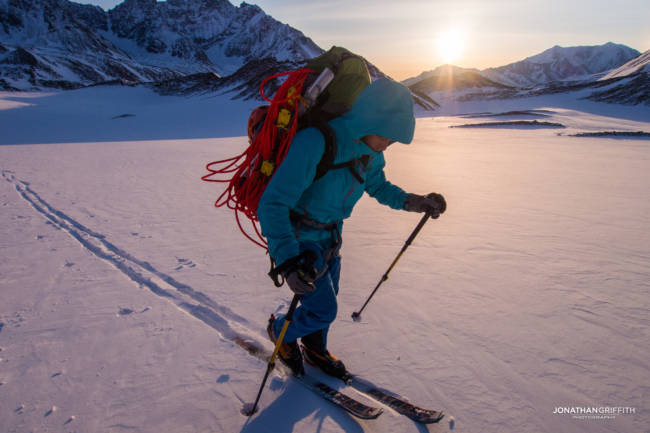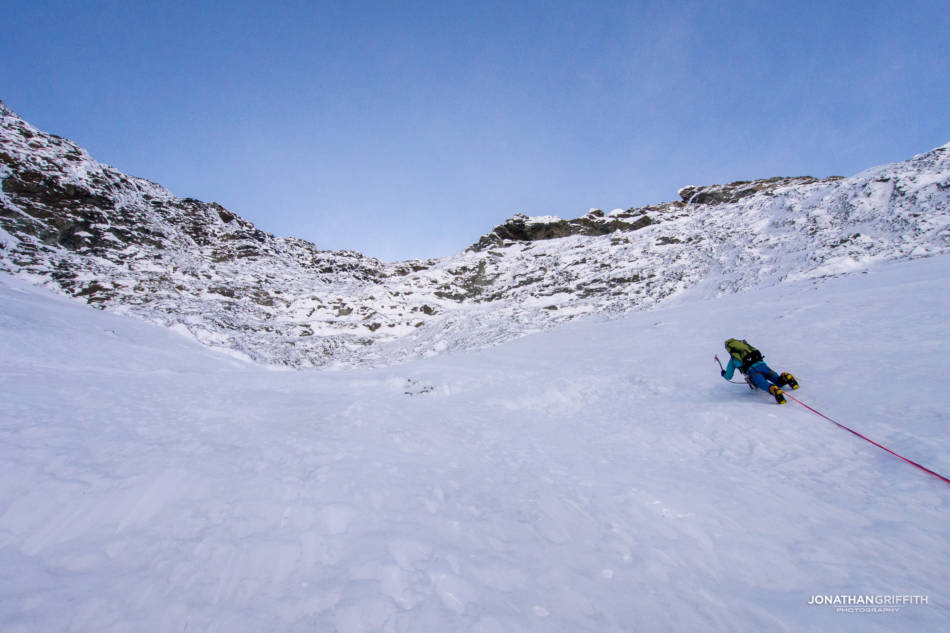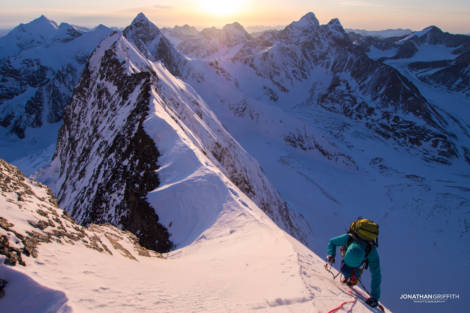
Alaska 2015: NW Face of Mt Deborah
At 5am the wind started. We had heard it all night screaming like a Patagonian wind off the summit ridge of Mt Deborah 2000m above our Base Camp, but it had been calm in camp. At first it was just a fluttering of the tent fabric, then a stronger gust flattened my side of the tent, enough to wake me up instantly like a slap to the face. A few seconds later and the wind had made its slow but bullish progress down the high flanks of Mt Deborah and was tearing through our Base Camp. I tried my best to hold the canvas and poles back whilst Will scrambled outside only to find our walls had be blown over already. He tried to rebuild them but it wasn’t long before the gale hit hard and the tent was flattened completely. My head torch had died and pinned down under the broken poles and canvas I tried to fumble about for food and essentials to pack in to a couple of backpacks. Our first night on the glacier hadn’t been a great start.
A few months back myself and Will had been trying to find an adventurous trip to go on. Our research took us from ice climbing in Africa to Mt Logan and pretty much everywhere in between. The onus was on adventure though, it didn’t have to be the hardest or the biggest thing around, it just had to have some unknown thrown in to the equation. Eventually Will came across Mt Deborah and working off a Google Earth photo we packed our bags with everything but a fixed plan, there are after all few things more adventurous than heading off for a 2000m high Greater Ranges objective with only a satellite photo to go off of.
Arriving in Talkeetna our first hurdle presented itself when our bush pilot couldn’t land us at the base of Mt Deborah due to the lack of snow that winter. All dressed and packed ready to fly that morning we instead spent the next couple of days frantically calling bush pilots in Fairbanks, eventually finding a helicopter pilot willing to take us there. The slight drawback being that we had to get ourselves, our food, and all our gear 300 miles up North and we didnt have a car. Hitching a lift can be hard enough, but hitching a lift with 200kgs of equipment was just the start of our adventure.

End of the bus line, time to hitch

Only in Alaska can you hitch with this much kit
We hitched to Cantwell, helped our pilot, Alex, mend a helicopter, got drunk in an exceptionally seedy bar, and basically put our expedition in to the hands of people that we’d never met before. At this stage it felt like we were just along for the ride, getting to our objective seemed like a far flung thought. Nevertheless nearly a week after landing an Anchorage the tiny Robinson R44 spluttered in to life, revving like a two stroke lawnmower, and we crammed in heading South in to the Hayes Range. Cresting the moraine that marks the start of the range we were instantly buffeted by winds, looking down at the glacier and it was obvious that this was a very windy part of the world. This wouldn’t be like the other glaciers we’d been to in Alaska.

Robinson R44 - the Danger Zone

Our pilot, and all round legend, Alex

Will gets excited for the fly in

Entering the Hayes Range
The range was socked in but we could just get enough visibility to access a spot beneath our face- it was a menacing day to arrive and the face reared up far in to the clouds above us. Jumping out of the R44 the first thing that struck us was that there were no sheltered spots anywhere on this glacier. It had the undulating form of a wind swept hell hole and I was starting to have serious doubts about my decision to bring a roomier 3 season tent than a bombproof low ceiling 4 season one. The snow walls went up as did the tent and we stopped for the day, we would finish camp off the following morning. But by midnight we could hear the low and powerful rumbling of winds high up on Mt Deborah and by 5.15am I had crawled out in to the mayhem clutching a couple of bags of essential items to see us through this storm.
It wasn’t a great start, but after years of climbing together all over the world it wasn’t something that worried us too much. As we piled in to the First Light tent, tucked right in to the wall Will had re-erected, we passed out, exhausted from the battering of the last few hours, not much to say. The storm raged and stuck in our bivy tent there really was nothing we could do, but now things started to feel a little more serious. The wind was intensifying, it built itself up in to powerful gusts that came from all angles announcing itself seconds before it hit with the sound of a freight train. Now thoughts turned to survival, our bivy tent looked on the brink of being torn apart and it was the only shelter we had left.

Will during the storm

Our destroyed Base Camp during the start of the storm

Bailing in to the First Light with the essentials
The wind eventualy died down and we got out of the tent to try and find a spot to dig a snow hole. We dug optimistically in to the wind blasted nevée bank beside us. It was tough going, the snow was bullet hard and there were old layers of ice, like rock strata, that had to be hacked through, but we made an opening, then a small cave as the storm intensified around us. It was turmoil outside, I got blown over on to my knees, snow got everywhere and stung the face. But we were making progress, and that felt reassuring at this stage. By evening we’d dug out a respectable snow cave and headed back to our bivy tent, worried that it was about to take off if we didnt weight it down. An hour later and the gale had built up even more, we struggled to hold the tent fabric up against the incoming blasts of wind. Minutes away from losing our First Light, we poured out of the tent, set on getting ourselves and the tent in to the shelter of the snow cave. I stumbled out in to the maelstrom, not having had time to get proper clothes or put my boots on, and we both grabbed an end of the tent. Predictably the entrance wasn’t big enough to accommodate the tent and as Will headed in first I found myself comically stuck outside in the storm with no boots or much clothing on with the ass end of the tent stopping me from getting in.
Eventually we both managed to get in and with a partly collapsed First Light providing a rudimentary door we settled in. It was cramped, damp, and dark. But the sensation of sitting there in a bombproof shelter whilst all hell raged outside was amazing- we went from almost losing our only shelter to being completely safe. If we hadn’t dug out this cave during the day time I’m not sure what would have happened that night. The wind intensified and as it punched past the entrance to our snow hole our ears popped and our inflatable mattresses jolted up and down from the change in air pressure.
I wondered if maybe there was a reason why no one ever came here.

Hard at work in our snow cave

Never a great sign when both tents are down
The morning didn’t provide any respite so we set about enlarging the snow cave; with nothing better to do we dug, then dug some more. Slowly but surely a sleeping platform, a kitchen, storage space, and even a sofa emerged. Two days later, and with aching backs we had created a masterpiece of a snow cave. The storm passed and we awoke to a prefect blue sky, now the world didnt seem so bad. It was time to start a fresh- dig out the collapsed tent that had all our gear and food, dry everything out, and get on with the actual expedition. It had been a pretty wild few days on the Gillam Glacier, and whilst it had had its really serious moments it was also good proof of what a years-long partnership can overcome.
We saw the face for the first time- it looked climbable even if it was huge. There were few seracs but instead there were monstrous cornices, in Alaska it always seems like it’s one or the other. All in all it looked like a pretty fast objective, but the storm had taught us a serious lesson- the weather is not to be underestimated out here. Our overriding thought during the previous three days was that with winds like that up high survival would be impossible. Mt Deborah is a very exposed peak and the low snow fall this winter would make trying to find a snow cave up on its steep face and ridge lines near impossible. We wouldn’t last 10 minutes in the storm we’d just encountered, let alone three days.

Will on our sleeping ledge

Myself at the other end of the cave

Sofa

After the storm had abated, the door was a little blocked

The luxury of sunshine and cooking outside

Our Snow Cave camp and Mt Deborah in the background

The wind was always with us though
The forecast announced a good window but we needed time to see the face and how it reacts. Heading in blind in to something that big is too much of a gamble, you never know how a face reacts when the sun hits it, which couloirs are the funnels, and which areas if any are safe. Big objectives weigh heavily on the mind at the best of times and so we watched the face in the evening light and were amazed to see that it was dead silent. It was peaceful, just how you want it to be. We went to bed thinking about leaving the next day, but by midnight it had started to snow again. And it snowed for the next 24 hours. The forecast was clearly not to be trusted either.
We’d traced a line through the heart of the face, it would be very threatened for the first third then would cover some more technical but safer ground til we toped out of the face. Or so we thought. Until that point we’d tied in together on over 50 ‘major’ alpine routes and 4 Greater Ranges trips, but we still read the face wrong.

Checking out the face in the evening light

The NW face of Mt Deborah at sunset
We left the safety of our snow palace and skied in to the base of the mountain with heavy packs. The unreliable forecasts and storm had made us go conservative- light and fast felt too exposed on Mt Deborah. At the bergshrund the face felt heavy above us, it was loaded but somehow the previous day nothing had budged. A heavy slide came down a couloir a hundred meters to the side of us; big enough to have taken us out if we’d been in it. A few words exchanged, but we both know exactly what the other is thinking. We’re pushing it and we both know it. I cross the bergshrund and in to the face. A few minutes later and another slide comes down the other side of our line. This didnt feel right at all, I stopped and looked down at Will who returned the look. He took one step forward and I turned around and continued on up.
It was tense. I was scared. The first 500m was a constant fight to move as fast as possible, but with a heavy pack, deep snow, and two 60m ropes dragging behind me I couldn’t move as fast as I wanted. The pro was non existent most of the time and I could glimpse the immense seracs to our left that threatened this part of the route and the dozens of gullies that fed high off the face down our line. If anything at all ripped out above us we wouldn’t stand a chance. So we kept going as fast as our legs would allow us until we were finally out of the worst of it.

Heading in to the face

Heading in to the face

Already high up on the NW face
Up until this point we had encountered surprisingly good nevée and there were few technical difficulties part from some steeper ice steps, but now we’d arrived at the crux of the route, and the crux wasn’t going to go. The rock was terrible, a series of overlapping black roofs with no cracks meant we had been completely shut down. To the right side a ramp of thin placage might just give us something to work with, something to traverse up and around this mess above us. In the back of our minds we knew that retreat was getting harder and harder, there was almost no V thread ice on this face, and the rock was devoid of anything useful for rap stations. Every pitch we went up made retreat even more complicated. The ramp linked up, only just at times, but it did link up.

Hitting the overlapping roofs

Following a line of thin ice placage to avoid the overhangs

On the ramp

As we traversed back left to join our main line Deborah awoke. The sun was starting its slow sweeping arch across the face starting with the far side, and in contrast to the previous day, the face came alive. Avalanches poured down from every angle, nothing was safe. The sun moves slowly in Alaska and upon arriving back in to our line and watching the mayhem inch across the face towards us we quickly abandoned our intended line and climbed as fast as we could to the far right of the face. We had to get off this thing as fast as possible.
But the sun caught up with us, it swung up high above our heads and the world came crashing down. The climbing on Mt Deborah is never too hard, but it’s thin, insecure, and run out. A lack of belays often meant we were simul climbing delicate terrain for multiple pitches with only a couple of bits of gear in between us; we know how each other climbs, what we couldn’t account for was one of us getting swept off the face. We were back in survival mode again. Moving together, twenty five meters out from a bomber ice screw, I found myself on a very thin bit of placage barely deep enough for two teeth of my axe as the first of the avalanches hit. It didn’t stop though, it kept intensifying, and I was completely stuck, hunched in to a ball minimising my surface area, waiting for it to finally rip me off my tiny insecure placements and take the biggest fall of my life. Gripped in a suffocating swirl of snow I thought over to the far side of the face and how the gullies there had been in near constant flow for hours and wondered whether I had just entered the equivalent on this side, I tried to hammer in a piton, convinced that I may be here for an hour unable to move.
It eased off after what felt like an age, but was only minutes. Shaken I traversed back over to my last screw and clipped in. That had been too close, I needed a moment to collect myself. I gladly handed the rack to Will and set up a belay as he led us up what turned out to be the crux of the route. We continued on our traverse, always on edge, eyeing up the monstrous cornices and snow mushrooms just above our heads, until we eventually topped out of the face on to the ridge above. Safe, finally.
“Let’s make sure that’s the most dangerous thing we ever climb together” I remember saying to Will as he joined me on the ridge in the setting sun. It had been a long and stressful day.

Just one of dozens of avalanches that came pouring down

Trying to escape the face but not avoiding all the avalanches

Sunset over the face


Will tops out and to safety

Will tops out and to safety

Digging out a tent ledge out of the wind

Tired but happy to be off the face

Well earned dinner
At 4am the wind picked up on the ridge, we’d dug in as best we could but you can’t escape the wind on Deborah. Will has an uncanny ability to sleep through any bivy, but after half an hour of indecision whether to leave the poles up or collapse the tent on us I had to wake him up. I was holding up the sides of the tent against the wind and scared we were going to lose the First Light. He mumbled something briefly to me then went straight back to sleep; I squirmed out in to the outside world and added more guy lines if only to help my mind ease itself to sleep.
The main summit of Mt Deborah still lay a long way away from us. The winds had moved higher up the mountain and we packed for a light and fast hit, hoping to make it back to our bivy spot before the day was over. We slipped back in to our usual style of climbing. With light packs and minimal gear we made fast progress soloing up to the summit ridge far above. Looking back at our bivy spot we couldn’t make it out anymore, it was a lot further than we though. Deborah had deceived us once again. As we arrived at the heavily corniced summit ridge we tied in and and simul climbed our way for hours through howling winds and mad snow formations until eventually we stood as close to the summit as we dared. After everything we had been through it was a miracle that we were stood the two of us on this singular patch of corniced snow.

The following morning

Wakey Wakey


Soloing up faster ground

Approaching the corniced summit ridge





On the summit with the South Summit of Mt Deborah in the distance

Summit!
Our descent line took away too much rejoicing on the summit. We would have to rap the South Side of the mountain and walk down the heavily crevassed and threatened Yanert glacier before climbing back up to our bivouac spot. Hours later and exhausted we arrived back at our campsite, it was a beautiful evening and mercifully the wind had finally left us in peace. But the unknown was still lurking, we still had to bail down the North side of the mountain, and what we’d seen so far on the NW face hadn’t been very inspiring. We descended the ridge as far as we could- soloing over a mile of loose and exposed piles of shale until we arrived at a point that we had traced out a descent line from Base Camp. The day had warmed up, the snow had become heavy. The huge winter cornices that lined this whole ridge and overhung our descent line were starting to sag with the first warm day of the year and my stomach churned as I headed off on the first rap beneath them. But we made it down somehow; every belay an inventive solution, every rap closer to the safety of the Gillam Glacier far below that had been so inhospitable when we first arrived.

The start of the long raps down to the Yanert Glacier on the South Side


Back at our bivy site for the night

The mile long down climb horror show

The mile long down climb horror show

The mile long down climb horror show
Back at Base Camp looking back up at the face, the euphoria slowly seeping through our minds fuelled by every dram of whisky that we drank, the MP3 player skipped to Bad to the Bone; nothing could have been more fitting for the adventure we’d been through. It really had been Bad to the Bone.

Bad to the Bone, Mt Deborah

Mt Deborah and the North West Face



